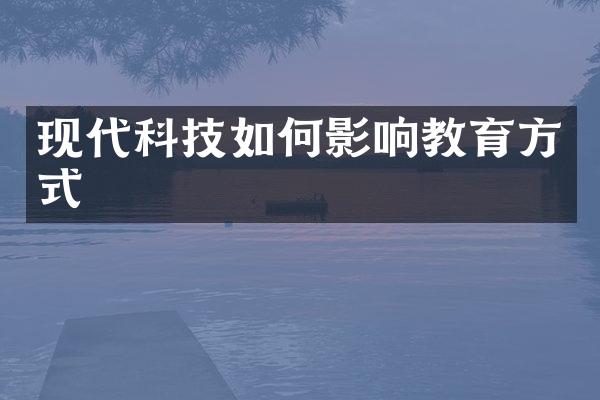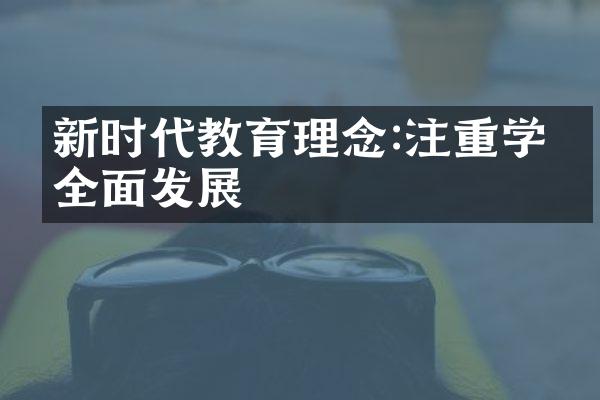以下是一篇关于新时代教育理念的800字文章:新时代,教育理念步前进时代在不断变迁,教育也应与时俱进。的报告明确提出,要"坚持育人为本,全面贯彻新发展理念"。新时代的教育理念应该做到哪些方面?首先,要注重学生的全面发展
Title: The Impact of Modern Technology on Educational Methods

Introduction:
In today's rapidly evolving world, modern technology has significantly reshaped various aspects of human life, including education. With the advent of digital tools, online platforms, and innovative applications, the traditional methods of teaching and learning have undergone a profound transformation. This essay explores the multifaceted impact of modern technology on educational methods, highlighting its benefits, challenges, and the evolving landscape of learning in the digital age.
Enhanced Access to Information:
One of the most notable advantages of modern technology in education is the unprecedented access to information it provides. The internet has become a vast repository of knowledge, offering limitless resources for students and educators alike. With just a few clicks, learners can access scholarly articles, online courses, instructional videos, and interactive tutorials on virtually any subject. This accessibility has democratized education, breaking down barriers of geography, socioeconomic status, and physical limitations.
Personalized Learning:
Another significant impact of modern technology on education is the rise of personalized learning experiences. Adaptive learning platforms and intelligent tutoring systems use algorithms to analyze students' strengths, weaknesses, and learning preferences, enabling tailored instruction that caters to individual needs. Through adaptive assessments and targeted feedback, students can progress at their own pace, fostering a deeper understanding of the material and enhancing overall engagement.
Collaborative Learning Environments:
Technology has also facilitated collaboration and communication among students and educators, transcending the boundaries of traditional classrooms. Online forums, virtual classrooms, and collaborative tools allow learners to connect with peers and instructors from around the globe, fostering a sense of community and expanding the scope of learning beyond the confines of the physical classroom. Through collaborative projects, group discussions, and peer feedback, students develop essential skills such as teamwork, communication, and critical thinking.
Interactive Multimedia Resources:
The integration of multimedia resources has revolutionized educational content delivery, making learning more engaging and interactive. Textbooks have been supplemented, if not replaced, by multimedia-rich digital resources that incorporate videos, animations, simulations, and interactive exercises. These multimedia elements cater to diverse learning styles, reinforcing concepts through visual, auditory, and kinesthetic modalities. As a result, students are more likely to retain information and develop a deeper understanding of complex concepts.
Blended Learning Models:
Modern technology has paved the way for blended learning models that combine traditional face-to-face instruction with online learning components. Blended learning offers the flexibility of asynchronous learning activities combined with the benefits of real-time interaction and support from instructors. By blending the best of both worlds, educators can optimize learning outcomes while accommodating diverse learning preferences and schedules. Blended learning has gained traction in both K-12 and higher education settings, offering a flexible and adaptive approach to instruction.
Challenges and Considerations:
While the impact of modern technology on education is largely positive, it also presents certain challenges and considerations. One of the primary concerns is the digital divide, which refers to the gap between those who have access to technology and those who do not. Addressing this disparity requires concerted efforts to ensure equitable access to digital resources and bridge the divide through initiatives such as community technology centers, subsidized internet access, and device distribution programs.
Moreover, the pervasive use of technology in education raises concerns about screen time and its potential impact on students' health and well-being. Excessive screen time has been linked to issues such as eye strain, sleep disturbances, and decreased physical activity. Educators and policymakers must prioritize strategies to promote balanced screen time habits and mitigate the adverse effects of excessive technology use.
Additionally, the rapid pace of technological advancement necessitates ongoing professional development for educators to effectively integrate technology into their pedagogical practices. Teachers require training and support to leverage digital tools, design engaging online activities, and facilitate meaningful learning experiences in virtual environments. Investing in teacher training programs and professional learning communities can empower educators to harness the full potential of technology in education.
Conclusion:
In conclusion, modern technology has profoundly transformed educational methods, offering enhanced access to information, personalized learning experiences, collaborative environments, interactive multimedia resources, and blended learning models. While technology holds great promise for improving educational outcomes and expanding opportunities for learners, it also presents challenges such as the digital divide, concerns about screen time, and the need for ongoing teacher professional development. By addressing these challenges and harnessing the potential of technology responsibly, we can create a more inclusive, engaging, and effective learning environment for generations to come.
标签:教育方
IT百科:
网者头条:
王哲博客:常州seo网络推广软件系统

 1
1